PatrickLondon
100+ Posts
You might not think of Hamburg as a tourist destination, but if you like port cities and the atmosphere that goes with them, it has a lot going for it. Most of the city centre fits between the Elbe river and the open lakes, the inner and outer Alster, surrounded by pleasant residential districts.

The Alster from the Rathaus
My home exchange was in Eimsbüttel, a few U-Bahn stations away from the city centre. The city's excellent public transport took me anywhere I wanted, but plenty of people cycle.
What to see:
Rathaus:
The city's massive Rathaus replaced a mediaeval predecessor sacrificed to create a firebreak during the great fire of 1842 that destroyed the mediaeval heart of the city. It therefore dates from the same era as the equally show-off Victorian town halls of the more recent industrial cities of Britain. From the intricate casting of the entrance gates, rooms and staircases lined with marble, onyx columns, intricate carving and inlay on doors and panelling, felted and leather wall coverings, ornate candelabra, plush upholstery and grandiose paintings and statues: all underline what a confident and competent company of citizens can do. Royal patronage and pomp gets a bare nod here and there. The building underlines that, as with the other Hanseatic cities, Hamburg's strength is in trade, business and craft. During my visit there was a display in the entrance on all that the relevant trade organisations do to support the training and promotion of independent craft and artisan trades in Hamburg: as their predecessors have done for centuries, to judge by the opulent display in the public rooms of the building as the tour guide takes you round.
Also, as it happens, this building was barely affected by the other great firestorm on the city in the Second World War. There was a bomb that landed in the square outside that could have done severe damage; but it failed to explode. The detonator is on display in one of the meeting rooms. It looks like any other piece of finely-machined precision engineering: though no-one actually said so, its failure could be a symbol of what's happened in the long rivalry between Germany and Britain - and why.
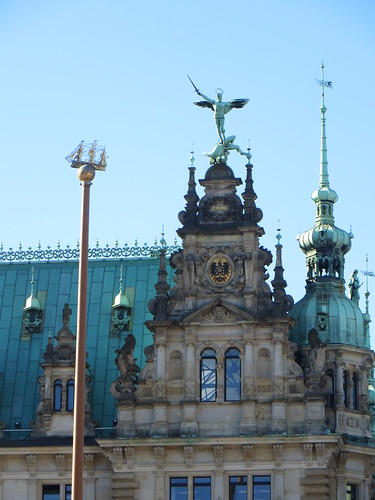
The grandeur of the Rathaus
The harbour and port:
There is a great deal of Hamburg harbour and port to be seen, and it's all close to the city centre. There's still a visible historical chain of harbour development, from little creeks (or "fleets") running up to what would have been merchants' houses, then to dedicated warehousing and docks (the nineteenth-century versions of which are now offices, flats and a very visible number of oriental carpet shops), these in turn being supplanted by a modern "Harbour City" set of developments, like so many other cities, complete with tourists gliding past on Segway tours. One difference here is that the housing includes plenty to rent, and the "anchor" building is the striking and gigantic new Elbphilharmonie - concert-hall, music education centre and public cultural space (complete with wavy roof).
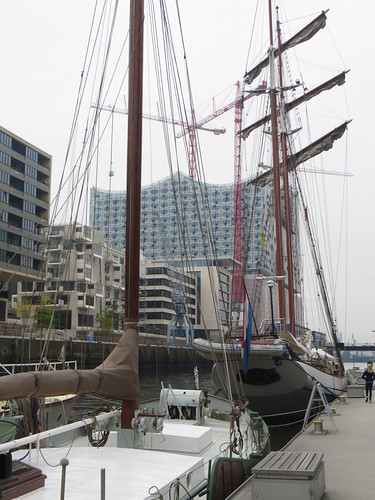
Hamburg old and new: Hafen City and the Elbphilharmonie
But what is most striking is the expanse of modern dock and port facilities on the other side of the river, with cranes and wind turbines and other industrial facilities stretching as far as the eye can see. What seemed, on my childhood visit to the Pool of London, to be huge freighters (one last remaining example sits here as a museum and visitor attraction) now seem quite modest, when compared with bigger and bigger container ships. Where London's docks moved out to the sea to accommodate the new behemoths, in Hamburg it's possible to live in the local millionaires' row, stroll on the beach, admire a museum collection of traditional sailing boats or visit a Soviet-era submarine, while watching a ship with thousands of freight containers on board coming right into the city centre, or some massive cruise ship being refitted on the other side of the river.
There are plenty of boats offering guided tours with commentary, but a cheap way to get a tour is to take one of the public service ferries - it won't take you into into all the nooks and crannies of the port, but you still see a fair amount.

Museum ships and working port
Architecture, arts and culture:
The harbour panorama is dominated by the stern-looking tower of the Michaeliskirche, but inside, the church is far less austere and more baroquely curvaceous than you might imagine a Lutheran church to be - with a grand organ case in each of the three galleries. But a gallery window, high in the ceiling, looks distinctly like part of an eighteenth century ship: and the whole church is as broad in the beam and curvaceous as the freighters that brought the wealth to build it.
It isn't all about work and money: the merchants and citizens liked spending their money on the mind and soul as well.
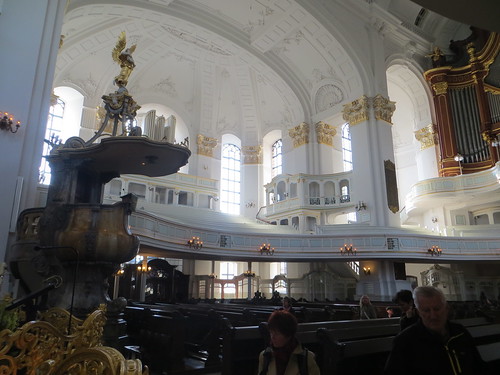
The curvaceous Michaeliskirche
And as all good nineteenth century citizens did, they endowed art galleries, with the Kunsthalle's large collection containing some of the best-known Caspar David Friedrichs, which was a bonus for me. Not far away, the Kunst und Gewerbe Museum is a smaller version of the Victoria and Albert Museum. It has a large collection of musical instruments, including the weird and the wonderful; and on this occasion a special exhibition devoted to what constitutes bad taste - with an opportunity for members of the public to contribute their kitschy items (on condition that they take one of someone else's away with them).
The purely functional has its decorative element too. Not a few old office blocks still retain some art nouveau decorations and entrances, and even the Elbtunnel, with its massive lifts for cars as well as pedestrians is lined with ceramic panels depicting its marine environment.
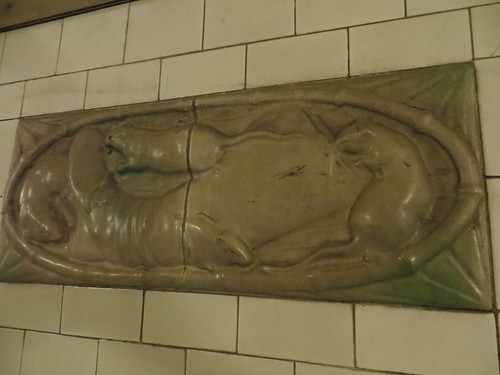
Elbtunnel panel: rats chasing round a workman's boot
Lübeck
A short commuter train ride away from Hamburg, Lübeck is another Hanseatic trading city, linked to the Baltic as Hamburg is to the North Sea and the Atlantic; but it feels much smaller, and with more of its mediaeval and merchant core retained (or restored and re-created), the focus seems to be on a much more relaxed sort of tourism.
But for all that, it boasts connections to three significant modern Germans, so the historically-minded culture vulture could spend a fair amount of time finding out more about Willy Brandt, Günter Grass, or (as I did, since that was the only one open that day) Thomas and Heinrich Mann.
Or you could just stroll the remaining cobbled streets and snaffle up the products of the Niederegger marzipan factory.
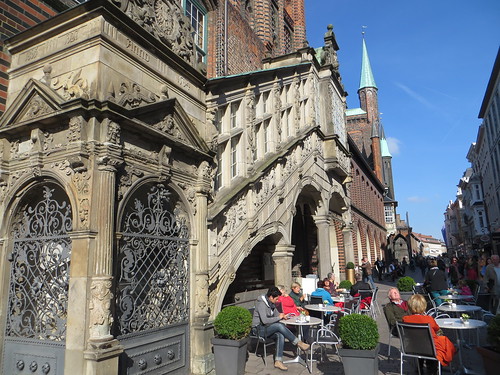
Lübeck - by the Rathaus
Links and resources:
Hamburg tourist information
HVV - Hamburg public transport
Kunsthalle
Kunst und Gewerbe Museum
Elbphilharmonie
Michaeliskirche
Elbtunnel
Museum ships in Hamburg
Lübeck tourist information

The Alster from the Rathaus
My home exchange was in Eimsbüttel, a few U-Bahn stations away from the city centre. The city's excellent public transport took me anywhere I wanted, but plenty of people cycle.
What to see:
Rathaus:
The city's massive Rathaus replaced a mediaeval predecessor sacrificed to create a firebreak during the great fire of 1842 that destroyed the mediaeval heart of the city. It therefore dates from the same era as the equally show-off Victorian town halls of the more recent industrial cities of Britain. From the intricate casting of the entrance gates, rooms and staircases lined with marble, onyx columns, intricate carving and inlay on doors and panelling, felted and leather wall coverings, ornate candelabra, plush upholstery and grandiose paintings and statues: all underline what a confident and competent company of citizens can do. Royal patronage and pomp gets a bare nod here and there. The building underlines that, as with the other Hanseatic cities, Hamburg's strength is in trade, business and craft. During my visit there was a display in the entrance on all that the relevant trade organisations do to support the training and promotion of independent craft and artisan trades in Hamburg: as their predecessors have done for centuries, to judge by the opulent display in the public rooms of the building as the tour guide takes you round.
Also, as it happens, this building was barely affected by the other great firestorm on the city in the Second World War. There was a bomb that landed in the square outside that could have done severe damage; but it failed to explode. The detonator is on display in one of the meeting rooms. It looks like any other piece of finely-machined precision engineering: though no-one actually said so, its failure could be a symbol of what's happened in the long rivalry between Germany and Britain - and why.

The grandeur of the Rathaus
The harbour and port:
There is a great deal of Hamburg harbour and port to be seen, and it's all close to the city centre. There's still a visible historical chain of harbour development, from little creeks (or "fleets") running up to what would have been merchants' houses, then to dedicated warehousing and docks (the nineteenth-century versions of which are now offices, flats and a very visible number of oriental carpet shops), these in turn being supplanted by a modern "Harbour City" set of developments, like so many other cities, complete with tourists gliding past on Segway tours. One difference here is that the housing includes plenty to rent, and the "anchor" building is the striking and gigantic new Elbphilharmonie - concert-hall, music education centre and public cultural space (complete with wavy roof).

Hamburg old and new: Hafen City and the Elbphilharmonie
But what is most striking is the expanse of modern dock and port facilities on the other side of the river, with cranes and wind turbines and other industrial facilities stretching as far as the eye can see. What seemed, on my childhood visit to the Pool of London, to be huge freighters (one last remaining example sits here as a museum and visitor attraction) now seem quite modest, when compared with bigger and bigger container ships. Where London's docks moved out to the sea to accommodate the new behemoths, in Hamburg it's possible to live in the local millionaires' row, stroll on the beach, admire a museum collection of traditional sailing boats or visit a Soviet-era submarine, while watching a ship with thousands of freight containers on board coming right into the city centre, or some massive cruise ship being refitted on the other side of the river.
There are plenty of boats offering guided tours with commentary, but a cheap way to get a tour is to take one of the public service ferries - it won't take you into into all the nooks and crannies of the port, but you still see a fair amount.

Museum ships and working port
Architecture, arts and culture:
The harbour panorama is dominated by the stern-looking tower of the Michaeliskirche, but inside, the church is far less austere and more baroquely curvaceous than you might imagine a Lutheran church to be - with a grand organ case in each of the three galleries. But a gallery window, high in the ceiling, looks distinctly like part of an eighteenth century ship: and the whole church is as broad in the beam and curvaceous as the freighters that brought the wealth to build it.
It isn't all about work and money: the merchants and citizens liked spending their money on the mind and soul as well.

The curvaceous Michaeliskirche
And as all good nineteenth century citizens did, they endowed art galleries, with the Kunsthalle's large collection containing some of the best-known Caspar David Friedrichs, which was a bonus for me. Not far away, the Kunst und Gewerbe Museum is a smaller version of the Victoria and Albert Museum. It has a large collection of musical instruments, including the weird and the wonderful; and on this occasion a special exhibition devoted to what constitutes bad taste - with an opportunity for members of the public to contribute their kitschy items (on condition that they take one of someone else's away with them).
The purely functional has its decorative element too. Not a few old office blocks still retain some art nouveau decorations and entrances, and even the Elbtunnel, with its massive lifts for cars as well as pedestrians is lined with ceramic panels depicting its marine environment.

Elbtunnel panel: rats chasing round a workman's boot
Lübeck
A short commuter train ride away from Hamburg, Lübeck is another Hanseatic trading city, linked to the Baltic as Hamburg is to the North Sea and the Atlantic; but it feels much smaller, and with more of its mediaeval and merchant core retained (or restored and re-created), the focus seems to be on a much more relaxed sort of tourism.
But for all that, it boasts connections to three significant modern Germans, so the historically-minded culture vulture could spend a fair amount of time finding out more about Willy Brandt, Günter Grass, or (as I did, since that was the only one open that day) Thomas and Heinrich Mann.
Or you could just stroll the remaining cobbled streets and snaffle up the products of the Niederegger marzipan factory.

Lübeck - by the Rathaus
Links and resources:
Hamburg tourist information
HVV - Hamburg public transport
Kunsthalle
Kunst und Gewerbe Museum
Elbphilharmonie
Michaeliskirche
Elbtunnel
Museum ships in Hamburg
Lübeck tourist information
